
Yellow Medicine County is a county in the State of Minnesota. Its eastern border is formed by the Minnesota River. As of the 2020 census, the population was 9,528. Its county seat is Granite Falls.

Lac qui Parle County is a county in the U.S. state of Minnesota. As of the 2020 census, the population was 6,719. Its county seat is Madison.
Lac qui Parle Township is a township in Lac qui Parle County, Minnesota, United States. The population was 183 at the 2000 census.

Madison is a city in Lac qui Parle County, Minnesota, United States, along the 45th parallel. The population was 1,376 at the 2020 census. It is the county seat of Lac qui Parle County. It proclaims itself to be the "lutefisk capital of the USA."

The Lac qui Parle River is a tributary of the Minnesota River, 118 miles (190 km) long, in southwestern Minnesota in the United States. A number of tributaries of the river, including its largest, the West Branch Lac qui Parle River, also flow in eastern South Dakota. Via the Minnesota River, the Lac qui Parle River is part of the watershed of the Mississippi River, draining an area of 1,156 square miles (2,990 km2) in an agricultural region. Slightly more than two-thirds of the Lac qui Parle watershed is in Minnesota. Lac qui parle means "lake which speaks" in the French language, and was a translation of the Sioux name for Lac qui Parle, a lake on the Minnesota River upstream of the mouth of the Lac qui Parle River.
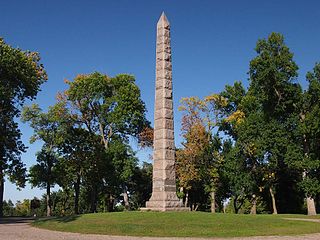
Camp Release State Monument is located on the edge of Montevideo, Minnesota, United States, just off Highway 212 in Lac qui Parle County, in the 6-acre Camp Release State Memorial Wayside. The Camp Release Monument stands as a reminder of Minnesota's early state history. The Minnesota River Valley and Montevideo were important sites in the Dakota War of 1862.

Lac qui Parle State Park is a state park of Minnesota, United States, near Watson. Lac qui Parle is a French translation of the native Dakota name, meaning "talking lake".
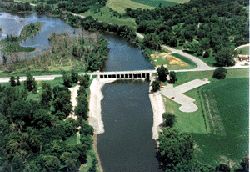
Lac qui Parle is a reservoir located in western Minnesota, United States, which was formed by the damming of the Minnesota River. The dam was built by the Works Progress Administration (WPA) in 1939. It was reconstructed in 1996. Lac qui Parle is a French translation of the native Dakota name, meaning "lake which speaks".
Minnesota State Highway 40 (MN 40) is a 72.723-mile-long (117.036 km) state highway in west-central Minnesota, which travels from South Dakota Highway 20 (SD 20) at the South Dakota state line near Marietta and continues east to its eastern terminus at its intersection with County State-Aid Highway 5 (CSAH 5) in Willmar.

Joseph Renville (1779–1846) was an interpreter, translator, expedition guide, Canadian officer in the War of 1812, founder of the Columbia Fur Company, and an important figure in dealings between white men and Dakota (Sioux) Indians in Minnesota. He contributed to the translation of Christian religious texts into the Dakota language. The hymnal Dakota dowanpi kin, was "composed by J. Renville and sons, and the missionaries of the A.B.C.F.M." and was published in Boston in 1842. Its successor, Dakota Odowan, first published with music in 1879, has been reprinted many times and is in use today.

The Lac Qui Parle County Courthouse, located at 600 6th Street in Madison, Lac Qui Parle County in the U.S. state of Minnesota is a Richardsonian Romanesque style building featuring a high central tower, built in 1899 at a cost of $30,689.
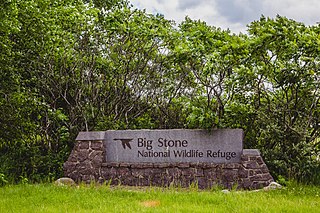
Straddling the headwaters of the Minnesota River in west-central Minnesota, Big Stone National Wildlife Refuge is within the heart of the tallgrass prairie's historic range. Today, less than one-percent of tallgrass prairie remains.
Minnesota State Highway 275 was a 6.519-mile-long (10.491 km) highway in southwest Minnesota, which ran from its intersection with Lac qui Parle County State-Aid Highway 2 in Boyd and continued north to its northern terminus at its intersection with U.S. Highway 212 in Baxter Township, 6 miles east of Dawson. It is now marked as Lac qui Parle County State-Aid Highway 29, and Lac qui Parle County Road 208 in the city limits of Boyd.

This is a list of the National Register of Historic Places listings in Lac qui Parle County, Minnesota. It is intended to be a complete list of the properties and districts on the National Register of Historic Places in Lac qui Parle County, Minnesota, United States. The locations of National Register properties and districts for which the latitude and longitude coordinates are included below, may be seen in an online map.
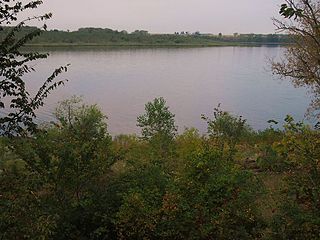
Fort Renville was a fur-trading post established by Joseph Renville and built in 1826. There are no visible remains at its site, a half mile from the Lac qui Parle Mission, in Lac qui Parle State Park near Watson, Minnesota, United States. It was a significant post during the fur-trading years, but fell out of use after Renville's death in 1846. The site was excavated in 1940 and is now held in preservation by the Minnesota Historical Society. It is not open to the public.
The Lac qui Parle Valley School District is a public school district in Lac qui Parle County, Minnesota.
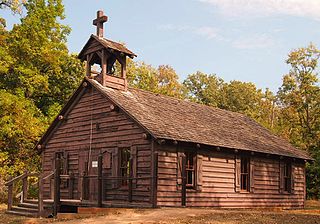
Lac qui Parle Mission is a pre-territorial mission in Chippewa County, Minnesota, United States, which was founded in June 1835 by Dr. Thomas Smith Williamson and Alexander Huggins after fur trader Joseph Renville invited missionaries to the area. Lac qui Parle is a French translation of the native Dakota name, meaning "lake which speaks". In the 19th century, the first dictionary of the Dakota language was written, and part of the Bible was translated into that language for the first time at a mission on the site of the park. It was a site for Christian missionary work to the Sioux for nearly 20 years. Renville was related to and had many friends in the native community, and after his death in 1846, the business was taken over by the "irreligious" Martin McLeod. The Indians became more hostile to the mission, and in 1854 the missionaries abandoned the site and relocated to the Upper Sioux Agency.
Lac qui Parle County Airport is a public use airport in Lac qui Parle County, Minnesota, United States. Also known as Bud Frye Field, it is located two nautical miles (4 km) southeast of the central business district of Madison. The airport opened in 2001 and it is owned by Lac qui Parle County and the cities of Madison and Dawson.
Lac qui Parle is a lake in Minnesota.
Lac qui Parle is an unincorporated community in Lac qui Parle Township, Lac qui Parle County, Minnesota, United States.











